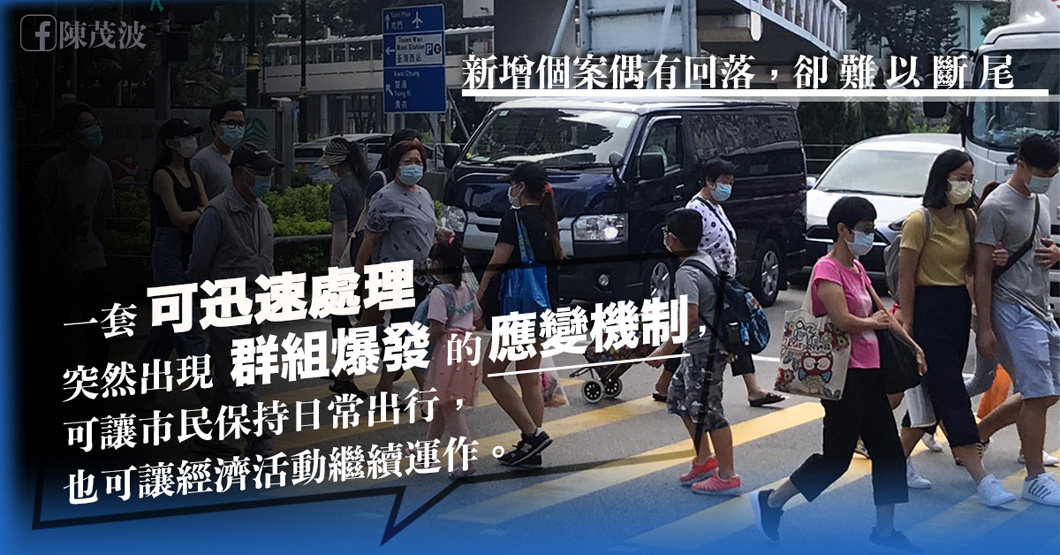Blog
Living with the epidemic
The situation of the COVID-19 pandemic around the world remains volatile, with a recent spike in new infection cases. The number of global daily new infection cases exceeded 330 000, which was the highest single day record. India, the US and Brazil are the three places with the largest number of new infection cases, which amounted to over 70 000, 50 000 and 30 000 in a single day respectively. The pandemic situation in Europe is also worrying. The Mainland earlier recorded 15 new infection cases, which were all imported ones, while there has not been any new local case for more than a month. These figures have clearly shown the effectiveness of the anti-epidemic work of the Mainland under the new normal. As for Hong Kong, we are now facing the question of how to avoid a resurgence of the epidemic and how to learn from our experience to better protect the health of our citizens and allow the resumption of free travel and economic activities.

|
After almost a year since the onset of the epidemic, people in different places start to accept the necessary measures for controlling the spread of the coronavirus, including wearing masks to prevent infections transmitted by respiratory droplets, keeping social distance or even more stringently staying at home, as well as identifying infected persons through testing. These measures help prevent the spread of the virus, but they are not sufficient to break the hidden chains of transmission in the community. Therefore, despite the occasional drops in the number of new infection cases, we are not able to eradicate the virus altogether. In particular, if physically weaker patients get infected, an outbreak is more likely to occur. This phenomenon has been seen repeatedly in many places which adopt similar anti-epidemic measures.
The Mainland has adopted a strategy to identify symptomatic or asymptomatic patients through large-scale and area-targeted testing, which is an effective way to break the chains of transmission. Nonetheless, such testing is not easy to implement and requires several rounds of cross checking to ensure precise results, the process of which requires time, determination, execution skills and the support of the community. At the same time, in order to achieve the goals of controlling the epidemic and supporting the economy, the Mainland has implemented the “health code” system. Under the risk assessment and identification mechanism, people who are confirmed not infected could resume travel and daily activities within a “safety circle” i.e. an area with effective anti-epidemic control. This is to allow the resumption of daily and economic activities to the largest extent for those people who have been tested and confirmed not infected.The experience of the Mainland shows that with large-scale community testing, together with quick containment at the early stage of an outbreak and a comprehensive risk identification system based on testing results, people could travel and carry out daily activities and enterprises could resume normal operation to the largest extent, within the shortest timeframe and under manageable risks. Of course, it is important for us to stay vigilant to prevent imported cases.
Most of us may agree that the current vicious cycle of “relax and rebounds” should be resolved, otherwise any real economy recovery would not be possible. Citizens and enterprises have been under huge stress since early this year and we have to find a way out. We should establish a response mechanism that could promptly handle any sudden cluster outbreaks. The mechanism should include large-scale and comprehensive testing and a risk identification system, allowing those citizens who are confirmed not infected to maintain convenient daily travel and the economy to function normally. More than 1.7 million citizens earlier participated in the Universal Community Testing Programme, which has provided us with valuable experience in handing registration, specimen collection, laboratory testing and result notification. The experience in running the process would facilitate us to establish a response mechanism that suits Hong Kong’s situation.
This pandemic of the century has hit the global economy hard and no one could escape from the challenges. How we tackle the challenges depends on our will and resolve. The epidemic in the Mainland has largely been brought under control and its economy has generally regained momentum. If we can effectively control the local epidemic situation in Hong Kong, hopefully we could resume the flow of people and exchanges of businesses with the Mainland and other places, thus giving a substantial boost to our economy.
October 11, 2020